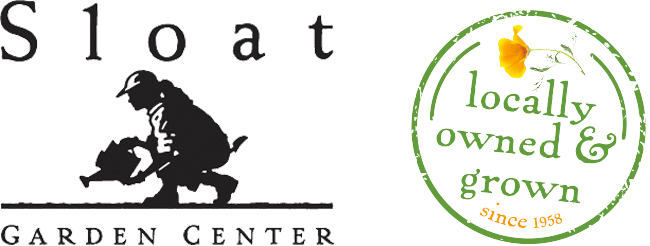It’s tomato growing season! Learn to successfully grow them with our tomato expert Dan Alexander – he shares planting tips, favorite varieties, and tomato planting combinations. We also troubleshoot solutions for the most common tomato growing challenges.
Scroll down for tomato growing notes and supply list.
Webinar: Tomato Growing 101
Supply list
- Sloat Organic Potting Soil
- Sloat Compost
- Loam Builder
- Recipe 420
- EB Stone Tomato/Vegetable Fertilizer
- Monterey Complete Disease Control
- Monterey BT
- Fish fertilizer
- Monterey Flori-Cal spray
- Tomato cages
- Packages of bamboo stakes and other 4-6” small diameter stakes
- One-gallon grower pots or equivalent
- ½ barrels, large fiber pots, 15/20 gallon fabric pots 15-gallon grower pots
- Trowel, gloves
All about Tomatoes
- Nightshade family (Solanaceae) Solanum lycopersicum
- Close relative of potatoes, shares many diseases
- More distant cousin of peppers, tomatillos and eggplant
as well as tobacco, nicotiana, petunias, million bells (Calibrochoa), deadly nightshade - Wild ancestors/origins in South/Central America
- Development as a food crop in Mexico. Carried to Europe, Asia and around the world by Spanish conquerors.
- Is it a Fruit or a Vegetable? Yes, it is. Discuss.
Concepts:
- Days to ripen
- Determinate/indeterminate
- Tomato leaf/potato leaf
- Heirloom
- Open pollinated
- Hybrid
- Organic or conventional
- V, F, etc.
- “Suckers” (also known as “branches”)
- What tomatoes like: sun/heat/drainage/fertilizer
- What tomatoes dislike: cold nights (under 60 degrees) excess heat (above 85-90)
- The best tomatoes to grow in cool areas come from cool areas
- Early, small, 70-days or less to maturity are a pretty sure thing.
- More than 70-days to ripen will, in reality, take considerably longer.
How to plant:
In ground: amend soil with manure, compost, add a balenced fertilizer with at least 3% calcium In container: use fresh good quality potting soil with added fertilizer. Minimum 2 cu.ft. Volume for full sized plants through the whole season. Smaller containers work for determinate plants and small varieties.
Plant starts/seedlings deep to obtain further root growth along the stem. Remove “seed leaves” (cotyledons) and first true leaves and plant deeply enough to cover scars of true leaves. BUT see instructions for Grafted Tomatoes below)
Grafted tomatoes can give you an advantage, especially with larger, later tomatoes. The desired tomato plant is grafted onto a tomato rootstock grown specifically for its vigor, disease resistance and tolerance of heat and cold. It is critical that the graft scar be planted above ground so that you can see it. If it is buried, roots will grow from above the graft, lessening the advantage of the rootstock.
Support for indeterminate tomatoes can be obtained by using tomato cages or stakes. If intending to use a cage, put it on early, before the plant gets too big. It’s disappointing to break a major limb trying to force it into the cage. If the plant is already big, then use a few stakes placed around and tie the branches, or use twine to form a sort of cage.
During the growing season: fertilize monthly (bi-weekly if in containers) starting when the first fruit sets.
Problems: Blossom end rot – lack of calcium often exacerbated by inconsistent watering
Tobacco mosaic virus – do not smoke around tomato plants or handle them after smoking without washing hands
Tomato horn worm – hand pick, can use BT
Fungal diseases (various leaf spot diseases) – avoid water on foliage and splash from soil. Water in the morning so things have dried out by evening
Fusarium/Verticillium wilt – soil born, once you have them, grow tomatoes in a different spot or in containers. Try Monterey Complete Disease Control, or Actinovate, bacterial fungicides.
Early blight – Alternaria solani fungus –”bull’s eye” leaf spots. Remove affected leaves, use Monterey fungicide.
Late blight – Phytophthora infestans fungus. The great potato famine disease. There are no resistant varieties developed for the Bay Area. Be sure to clean up all vegetation at the end of season and put in green can. Do not compost tomato plants in home compost bin.
Varieties that will do well in most of Bay Area
All cherry tomatoes. Stupice, Moskvitch, Early Girl, Beaverlodge Slicer and other Nordic/Siberian varieties that mature at less than 70 days. Look for names that imply Alaska, eastern Europe.
Slightly larger, later varieties include Sebastopol, Petaluma Hill Purple, Babywine. Larger yet, and later include Black Krim, Cherokee Purple, Paul Robeson, Berkeley Tie-Dye and the beefsteak varieties. Interesting specialties include Green Zebra, Mr. Stripey, Julia Child and many more.
Plant a variety (not all eggs in one basket). Keep track of what you plant to guide future choices. Share with your neighbors. Experiment. Have fun. Save seeds (not from hybrids).
Books: Pam Pierce, Golden Gate Gardening; Mel Bartholomew, All New Square Foot Gardening
Websites: www.sloatgardens.com; growbetterveggies.com; worldtomatosociety.com; tomatofest.com Marin Master Gardeners: www.marinmg.ucanr.edu. The public library has lots of resources and a seed exchange.


